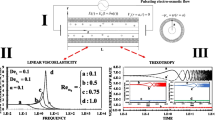Abstract
The physical and chemical properties of electrorheological (ER) fluids are reviewed, and an outline theory of their mode of action is proposed. Rheologically, the Bingham plastic model gives an acceptable representation of ER fluids flowing in a field and it has recently been shown that the plastic viscosity may be field-dependent in some circumstances, as well as the yield stress. The variation of the former with field is strongly influenced by the specific chemical nature of the ER fluid, while the field dependence of the latter has a similar form in all the ER fluids investigated. However, interpretation of observations is complicated by concentration of solid in the working gap and interplay between local electrical conductivity and shear rate.
Similar content being viewed by others
References
W. M. Winslow, Induced fibration of suspensions,J. Appl. Phys. 20(12):1137 (1949).
J. E. Stangroomet al., unpublished (1968).
D. L. Klass and M. T. Martinek,J. Appl Phys. 38:67 (1967).
Linda F. Evans, An evaluation of presently available electro-rheological fluids (1988). [Report available on private subscription from ER Fluid Developments Ltd.]
J. E. Stangroom and I. Harness, U. K. Patent No. 1570234 (1977).
J. E. Stangroomet al., unpublished (1973).
J. E. Stangroom, U. K. Patent No. 1501635 (1974).
H. Blochet al., U. S. Patent No. 4687589 (1987).
J. E. Stangroom, U. K. Patent No. 2100740 (1981).
J. E. Stangroom, U. S. Patent No. 4812251 (1989).
J. E. Stangroom, U. K. Patent No. 2153372 (1984).
J. E. Stangroom, unpublished (1968).
J. E. Stangroom, unpublished (1969).
J. E. Stangroomet al., unpublished (1976).
H. R. Kruyt and F. G. van Selms, The influence of a third phase on the stability of suspensions,Rec. Trav. Chim. 62:407 (1943).
J. E. Stangroomet al., unpublished (1988).
H. Conrad, Y. Chen, and A. F. Sprecher, Electrorheology of suspensions of zeolite particles in silicone oil, inProceedings of the 2nd International Conference on ER Fluids (Raleigh, North Carolina, 1989), p. 252.
J. E. Stangroom and I. Harness, unpublished (1973).
J. E. Stangroom and I. Harness, unpublished (1975).
J. E. Stangroom, Electrorheological fluids,Phys. Technol. 14:290 (1983).
J. E. Stangroom and I. Harness, unpublished (1978).
J. E. Stangroom, unpublished observations.
F. E. Fillisko and W. E. Armstrong, U. S. Patent No. 4744914 (1988).
J. E. Stangroom, unpublished observations (1968–1970).
J. E. Stangroom and I. Harness, unpublished (1989).
J. E. Stangroom, U. K. Patent No. 2119392 (1982).
J. E. Stangroom and I. Harness, unpublished (1982–1984).
F. A. Cotton and G. Wilkinson,Advanced Inorganic Chemistry (Interscience, 1962), p. 321.
Author information
Authors and Affiliations
Rights and permissions
About this article
Cite this article
Stangroom, J.E. Basic considerations in flowing electrorheological fluids. J Stat Phys 64, 1059–1072 (1991). https://doi.org/10.1007/BF01048814
Issue Date:
DOI: https://doi.org/10.1007/BF01048814




